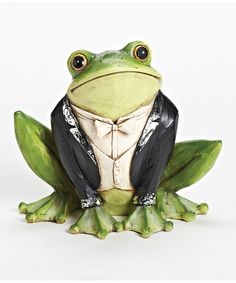As I was rummaging through my closet last night, looking for my barely-worn tuxedo, it donned on me that I didn't know how these so-called "monkey suits" came into existence. I took a break and consulted the Google Guru. They haven't been around for as long as one might think.
In the 1860's, the popularity of outdoor events among the British upper and middle classes led to the need for a more "casual" lounge suit for gentlemen. men were also looking for a less stuffy evening tailcoat that they could don every evening. The earlist record of a "tailless" coat being worn with evening wear was a midnight blue smoking jacket with matching trousers that was worm by the Prince of Wales (later King Edward VII). It was made by the famous London Saville Row tailors. Henry Poole & Company.
The garment, as we know it today, was also first describes about this time period and is often associated with the British seaside resort, Cowes. This community was synonymous with British yachting and was a favorite "hang-out" for the Prince of Wales. As it was simply a substitute for the evening tailcoat, it was worn with all the same accoutrements as the more formal tailcoat.
The earliest American reference to the dress coat substitute dates to the summer and fall of 1886. The most famous reference originates to Tuxedo Park, an upstate New York enclave for Manhattan's wealthiest citizens. An essay in the Tuxedo Park archives attributes the jackets importance to resident James Brown Potter, specifically, but the claim cannot be verified through independent sources. Period newspaper accounts indicate that the more casual evening jacket was worn by young mavericks to gatherings that were considered strictly formal. This, of course, led the American establishment to reject it out of hand. It wasn't until 1888 that "polite society" accepted it, but soles as a summer and informal evening substitute. This is when it's popularity began to soar. It has several slang names; monkey suit, penguin suit and, since 1918, soup and fish.
The style of the modern tuxedo changes from time to time; notched collars, fabric textures and colors, center vents, flap pockets and the number of buttons...all can be either "in" or "out" at any given time. But no matter how the tuxedo's style evolves and changes, it is still considered to be the "outfit of choice" for all formal occasions, both for humans and amphibians. In Britain, the name tuxedo most often refers to a white dinner jacket.
I may not like wearing a tux, but I do have to admit that I feel pretty dapper when I put it on. It does everyone good, I think, to dress up now and again. In these very casual times, it pretty easy to become a slob and although I might groan a bit, I am excited to be going out this weekend and Puttin' on the Ritz!
Have a great weekend. Stay safe and I hope you'll all join me back here on Monday.

 RSS Feed
RSS Feed